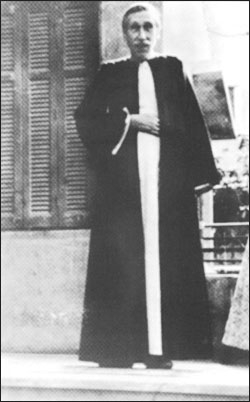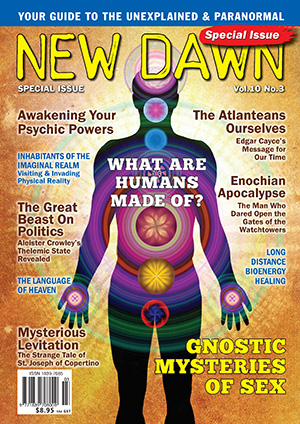From New Dawn Special Issue Vol 10 No 3 (June 2016)
A question nags at everyone today: are things getting better or worse? The answer depends on the criteria you’re using. In terms of material comfort, it seems clear that life is better and easier for most people – certainly most people in the West – than they were a century ago.
Yet somehow this is not reassuring. The very forces that have created these comforts threaten to destroy us. And in any case the complexities of advanced civilisation have by no means enabled us to feel that we, individually or collectively, have any meaningful place in the universe. Indeed there would seem to be powers that are trying to thwart this sense of meaning and to stamp it out whenever it raises its head. The works of René Guénon (1886–1951) attempt to deal with this problem.
Guénon is still little-known even among the mainstream intelligentsia. But his critique of the modern world – set out particularly in his books East and West, The Crisis of the Modern World, and The Reign of Quantity and the Signs of the Times – has become increasingly influential both in the West and in the Islamic world (Guénon, a convert to Islam, moved to Cairo in 1930 and lived there for the rest of his life).
Guénon starts with the concept of the yugas, the world ages as conceived in traditional Hindu metaphysics. The first and best is the Satya Yuga; next is the Treta Yuga; third is the Dvapara Yuga; the last, shortest, and worst is the Kali Yuga, the age of darkness. This is the age we are in. It began in 3102 BCE, with the end of the great war described in the epic known as The Mahabharata. Most Hindu sources say that the Kali Yuga will last 432,000 years – in short, we are nowhere near the end of it. Guénon sees the matter otherwise. In The Crisis of the Modern World he writes: “We have in fact entered upon the last phase of the Kali-Yuga, the darkest period of the ‘dark age’, the state of dissolution from which it is impossible to emerge otherwise than by a cataclysm.”
The reasons for Guénon’s belief are complex, but they have to do with his view of the ages as a gradual movement (and decline) from a pure and direct contact with the primordial source of Tradition, which he associates with prehistoric polar civilisation known as Hyperborea. Over the millennia, contact with this Tradition has become more and more occluded so that in our time we are almost entirely cut off from it. (For more about this, see my article “Waiting for the End of the World: René Guénon and the Kali Yuga” in New Dawn 122.)
The modern West is thus, for Guénon, not the summit of progress. It is at the tail end of a long decline. Although Guénon does not specify when this age will end, he seems to think it will be comparatively soon – a few decades from the time he is writing in the early to mid-twentieth century.

For Guénon, this decline is cyclical and thus inevitable. At the same time, despite his claims of holding himself above the fray, he displays a strong animus against the era. One senses a dissociation here. If materialism and the “reign of quantity” are omnipresent, surely it is a result of the cycle; things could hardly be different in the late stages of the Kali Yuga. In that case, why be upset about it?
Years ago I had a discussion with the philosopher Jacob Needleman in which I made this complaint about the Traditionalists. “It’s as if they’re mad because it’s November,” I said. (I am speaking from a northern-hemisphere perspective.) “No,” Needleman replied. “They’re mad because people are going around saying, ‘It’s May’.”
Needleman was right. Guénon’s time, the early twentieth century, was the high-water mark of Western triumphalism. Guénon felt a powerful need to fight this attitude as well as what he considered a deluded belief in “progress” and “evolution.” Indeed the very things that the West has trumpeted as signs of progress were, for Guénon, the sign of the very opposite: “Have we not arrived at that terrible age, announced in the Sacred Books of India, ‘when the castes shall be mingled, when even the family shall no longer exist’?” Most modern people would say that the decline of the caste system is a good thing.
Besides, Guénon did not think the woes of modernity could be blamed completely on a cyclical entropy. There were conscious factors at work as well. In The Reign of Quantity, he writes, “Since all effective action necessarily presupposes agents, anti-traditional action is like all other kinds of action, so that it cannot be a sort of spontaneous or ‘fortuitous’ production, and, since it is exercised particularly in the human domain, it must of necessity involve the intervention of human agents.”
This action comes in two stages. The first is one of “quantification and mechanisation.” Quantification is the warping of the modern mind so that it only perceives things in terms of number. Statistics are one example of this trend, and Guénon has an insightful chapter in The Reign of Quantity entitled “The Illusion of Statistics.” Also, the use of quantification in industry – as opposed to the “crafts” that flourished in traditional civilisations – “had the effect of attaching men more and more completely to purely material realisations. Man ‘mechanised’ everything and ended at last by mechanising himself, falling little by little into the condition of numerical units, parodying unity, yet lost in the uniformity and indistinction of the ‘mass’.” The result? Man loses practically all contact with higher realms. He is so focused on materiality that he believes nothing else exists.
A second phase ensues: “dissolution.” Guénon explains: “After having enclosed the corporeal world as completely as possible, it was necessary, while guarding against the re-establishment of any communication with superior domains, to open it up again from below, so as to allow the dissolving and destructive forces of the inferior subtle domain to penetrate into it. It is the ‘unleashing’ of these forces, so to speak, and the setting of them to work to complete the deviation of our world and effectively to bring it towards final dissolution, which constitutes the second part or second phase referred to.”
Guénon calls the sum total of these forces – who are, as he has emphasised, human – the “counter-initiation.” Now it is not merely a matter of being passively unaware of Tradition, but of forces that actively seek to block and divert this awareness.
Mark Sedgwick, author of Against the Modern World, an important study of Guénon and Traditionalism, observes: “Traditionalists are those who… recognise that one of the most important aspects of modernity is inversion – that the world sees the valuable as worthless and the worthless as valuable, the good as bad and bad as good. Guénon never saw a punk, but it would have made a lot of sense to him. And with that comes ‘counter-initiation’ – religious movements that are actually irreligious, that actually lead away from what religion is meant to lead to.”
Two of the most prominent “counter-initiatic” movements, in Guénon’s view, were Theosophy and Spiritualism. This is why he devoted two books to denouncing them. Theosophy was pernicious because it presented a loathsome parody of the genuine Traditional teachings of Hinduism. Moreover, in teaching the idea of the soul’s evolution – a word that was anathema to Guénon – it was presenting dangerous modern ideas in esoteric form.
Actually it is difficult to tease out the differences between Guénon’s views of the ascent of the Self through multiple states of being from the Theosophical model, which describes a very similar process. (One difference is that Theosophy posits multiple incarnations on earth, whereas Guénon denies it.) But he saw the very similarity of these views as yet another sign of the diabolical cleverness of the counter-initiation. Spiritualism too, with its séances, was stirring up “inferior forces.”
For a Traditionalist, practically every modern movement or school of thought can be – and is – seen as an example of “counter-initiation” at work. Psychoanalysis, for example, involves an excursion into the lower depths of the psyche from which the subject may well never return. “In the ‘fall into the mire’,” as Guénon characterises it, “the inferior possibilities take possession of him, dominate him, and end by submerging him completely.” Guénon makes a similar argument about the revivals of shamanism and “sorcery.” Eventually, he predicts, “counter-initiation” will lead to a “counter-tradition” – a grotesque and evil imitation of true Tradition.
Another symptom of the present crisis is syncretism: the random mixture of teachings and images from any number of traditions. For Guénon, this is radically different from synthesis, by which common themes and symbols are seen to be reflections of one universal Tradition. Someone might object that from the exterior, synthesis and syncretism are hard to tell apart. Guénon would say that is the point: from the exterior, one does not have knowledge to integrate these themes properly. It is only intellectual intuition – the possession of true knowledge – that makes this a possibility for initiates.
It does not take much imagination to see how many present-day trends fit into Guénon’s model. Mark Sedgwick mentions punk, but Guénon would have found every other form of popular music just as abominable. Similarly with the visual arts: he would have seen transgressive works such as the photography of Robert Mapplethorpe or Andres Serrano’s notorious Piss Christ as extreme examples of such degeneration – in the unlikely event that he deigned to take notice of them at all.
He may even have a point about the penetration of “the dissolving and destructive forces of the inferior subtle domain” into world. In his 1936 essay “Wotan,” psychiatrist C.G. Jung writes about the Germany of that time: “What is more than curious… is that an ancient god of storm and frenzy, the long quiescent Wotan, should awake, like an extinct volcano, to new activity, in a civilised country that had long been supposed to have outgrown the Middle Ages.” For Jung, much like Guénon, the terrible forces of the twentieth century were eruptions from the unconscious.
Guénon may even have been right about the deliberate evocation of such forces. Occultist Donald Tyson writes that the magus Aleister Crowley, a contemporary of Guénon’s, “firmly believed that he was the herald of a new age of strife and destruction that would sweep across the world. He called this the Aeon of Horus, after the Egyptian god of war.” [See article in this issue, ‘Enochian Apocalypse’ by Donald Tyson, page 43.] In 1909 Crowley conducted some magical workings to accomplish this end by opening “the four great Watchtowers that stand guard against chaos at the extremities of our universe.” Tyson writes:
Let us suppose for the sake of argument that… Crowley’s Enochian evocations of 1909… pried the doors of the Watchtowers open a crack – enough to allow a foul wind to blow through the common mind of the human race. This would explain the senseless slaughter of the First World War and the unspeakable horror of the Nazi Holocaust during the Second World War. It would explain the decline of organised religions and why the soulless cult of science has gained supremacy. It would explain the moral and ethical bankruptcy of modern times and the increase in senseless violence.
Whether or not Crowley really did open up the cosmic Watchtowers, he no doubt would have liked to think he did. In any case, this description sounds very much like what Guénon is talking about.
To go back to Guénon, no one can lay out such a comprehensive denunciation of a civilisation without offering some positive alternative. He evidently hoped that his works would inspire a nucleus of Western illuminates to gain access to, and perpetuate, the Traditional knowledge, either to reverse the decline of the modern world, or, more likely, to serve as an ark for the preservation of the sacred knowledge for a better future time.
To a small extent, his hopes have been realised. London’s Temenos Academy, for example, founded in 1990 by the poet Kathleen Raine and associates including the Traditionalist Philip Sherrard, is committed to perpetuating the “perennial philosophy” – another name for Guénon’s Tradition. The Prince of Wales is among its patrons. Indeed, as Angel Millar points out in his recent book The Compass and the Crescent: Islam, Freemasonry, Esotericism, and Revolution in the Modern Age, Prince Charles is very likely a Traditionalist himself, and his ideas and programs cannot be understood without reference to Traditionalism.
The number of people sympathetic to Traditionalism, of course, remains infinitesimal. But Guénon did not believe that mere numbers were necessary to influence the course of civilisation. Numbers, after all, are merely another manifestation of the reign of quantity. He believed that certain awakened individuals, even if only a few, could extend a powerful and beneficent influence on civilisation.
Was he right? We are certainly far from anything like a “reign of quality.” But history has a way of reversing course, and the prospects for a civilisation that incorporates a sense of the sacred may not be so dismal after all.
Sources
René Guénon, The Crisis of the Modern World, Translated by Arthur Osborne et al. Sophia Perennis et Universalis, 2004 [1942]
René Guénon, East and West, Translated by Martin Lings, Sophia Perennis et Universalis, 1994 [1941]
René Guénon, The Reign of Quantity and the Signs of the Times, Translated by Lord Northbourne, Penguin, 1972 [1953]
C.G. Jung, “Wotan.” www.philosopher.eu/others-writings/essay-on-wotan-w-
nietzsche-c-g-jung/; accessed April 3, 2016
Jean-François Mayer, “Traditionalism: René Guénon’s Legacy Today: An Interview with Mark Sedgwick,” ReligioScope, 2004; religion.info/english/interviews/article_53.shtml; accessed April 3, 2016.
Angel Millar, The Compass and the Crescent: Islam, Freemasonry, Esotericism, and Revolution in the Modern Age, Numen Books, 2015
Mark Sedgwick, Against the Modern World: Traditionalism and the Secret Intellectual History of the Twentieth Century, Oxford University Press, 2004
Donald Tyson, “The Enochian Apocalypse,” Gnosis 40 (summer 1996), 56–62
© New Dawn Magazine and the respective author.
For our reproduction notice, click here.



